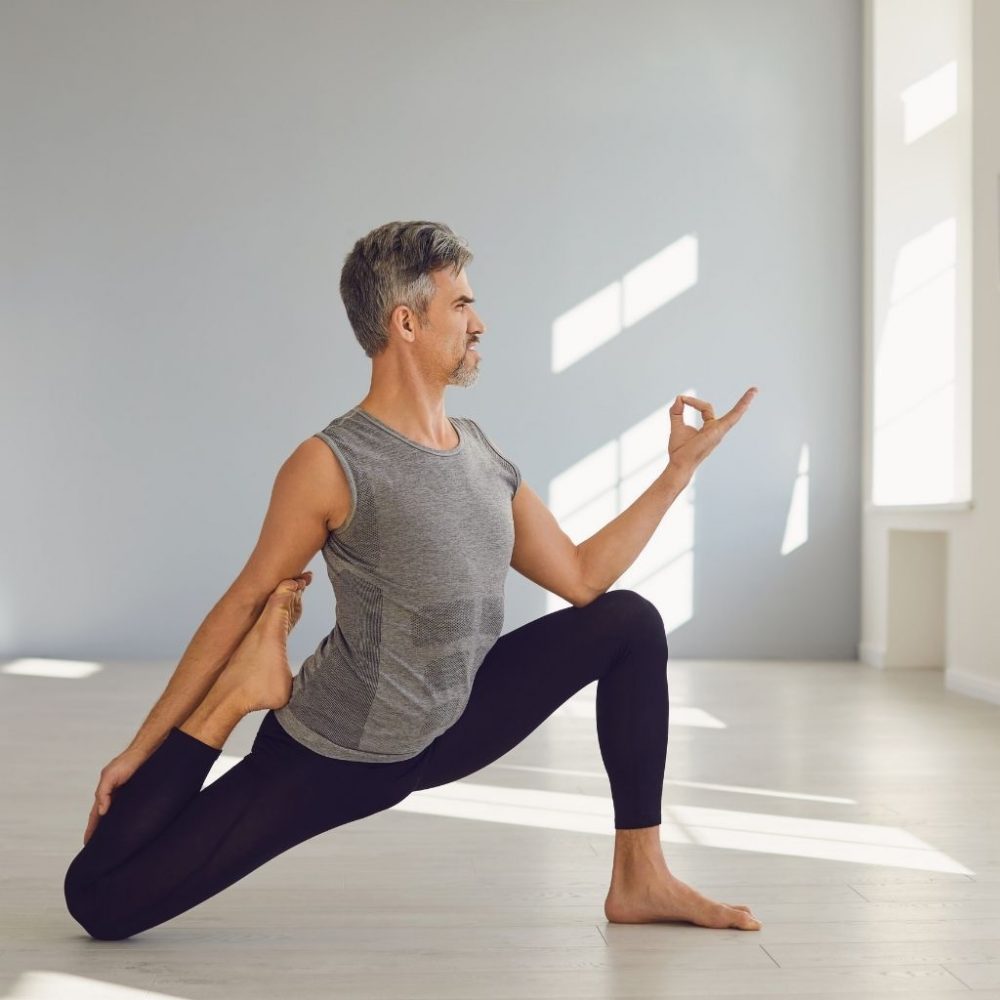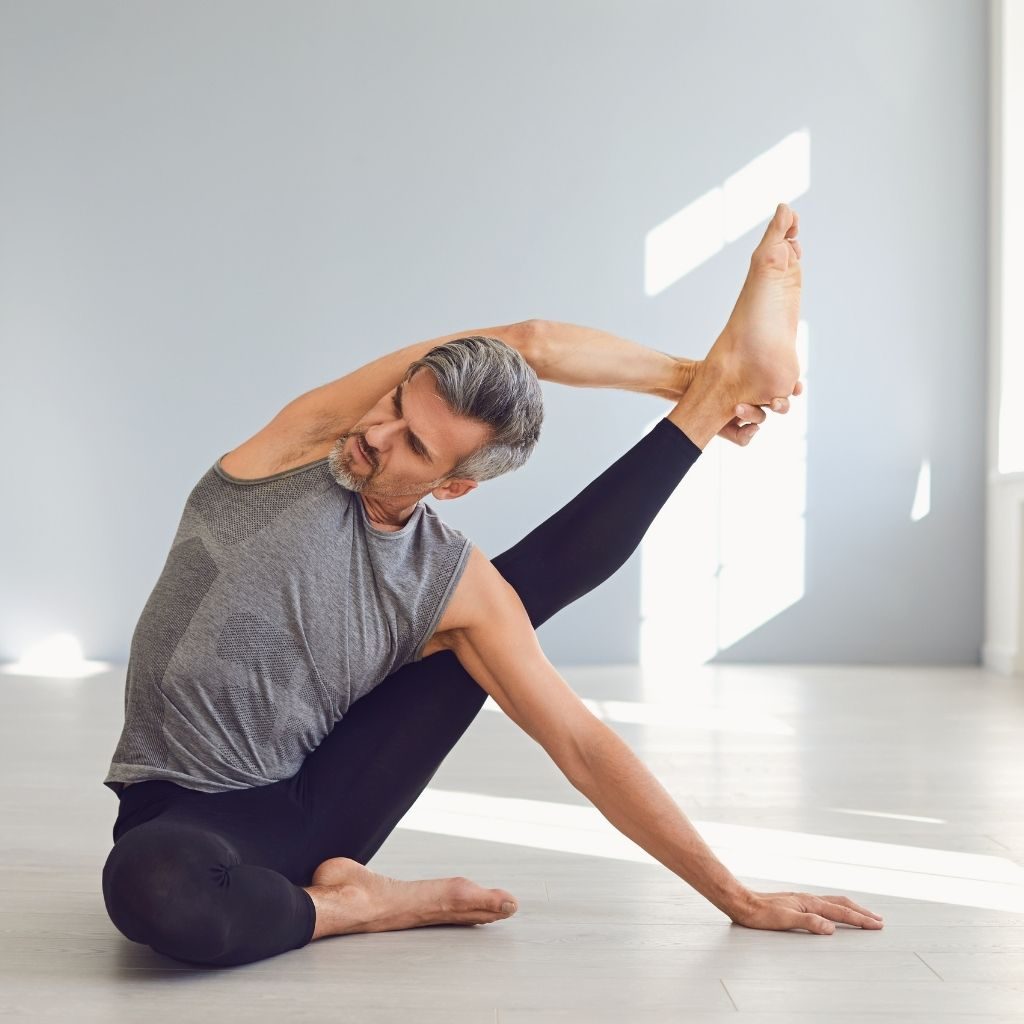Can I do The Same Yoga Routine Every Day?
You can do the same yoga routine every day. Repetition builds familiarity, which helps cultivate a feeling of being safe and grounded, and is especially beneficial for those who have anxiety. The same yoga routine is also helpful if there is a particular problem area in the body that the practice caters to, for example, back pain.

This article explores this question in detail.
It also answers the many questions that come up when establishing a yoga routine – how often should you change it, which components that can stay the same, can you get hurt if you do the same practice every day, and more.
Let us start with understanding if all yoga routines are the same.
Are all yoga routines the same?
Not all yoga routines are the same. Most yoga classes, however, follow the standard bell-curve sequencing. They start with centering or conditioning, raising the energy level, and then lowering it back by ending the practice with relaxation. While this structure may remain the same, there are endless variations that can be made to a yoga routine in terms of the included poses.
A typical yoga routine includes some warm-up poses, sun salutations, standing or balancing poses, forward bends, backward bends, spinal twists, and relaxation.
Within this routine, there are innumerable permutations and combinations that you can create to form a holistic yoga session.
Another way yoga routines are structured is by setting the goal of a peak pose and using the other poses as building blocks to get to that pose.
This, again, can be achieved in all kinds of ways.
Can you do the same routine all your life, or is it ok to change? We address this next.

How often should you change your yoga routine?
How often you should change your yoga routine depends on how your practice is making you feel. Whether you do a routine for one week or one month, it is crucial to assess if you feel more energized or depleted at the end of your practice. If you find your energy levels falling, you should think about changing your routine.
That said, changing your yoga routine needs an honest assessment.
As the saying goes – the yoga poses you avoid the most you need the most.
Sometimes, we avoid certain poses because they feel challenging, which could be why we want to change our routine.
How often you should change your yoga routine depends on how your practice is making you feel. Whether you do a routine for one week or one month, it is crucial to assess if you feel more energized or depleted at the end of your practice. If you find your energy levels falling, you should think about changing your routine.
That said, changing your yoga routine needs an honest assessment.
As the saying goes – the yoga poses you avoid the most you need the most.
Sometimes, we avoid certain poses because they feel challenging, which could be why we want to change our routine.
Sticking to the same routine is a great way to measure progress.
You will know it is time to change your yoga routine if your practice starts to feel mundane, you don’t feel challenged, or you feel exhausted or bored by the end of your practice.
Even with all the possible yoga routines, some components and structures remain constant. What are they?
You will know it is time to change your yoga routine if your practice starts to feel mundane, you don’t feel challenged, or you feel exhausted or bored by the end of your practice.
Even with all the possible yoga routines, some components and structures remain constant. What are they?
You may also like 👉 How to start doing yoga every day and stay consistent

What are the components of a yoga routine that you can practice every day?
The essential components of a yoga practice that you can practice every day are standing and balancing poses like mountain pose and tree pose lunges like crescent pose and warrior poses, forward bends, backward bends, spinal twists, and relaxation poses like savasana.
If you are a beginner, it is advisable to start small and choose the more accessible poses in these categories.
So, if you are doing backward bending, opt for a cobra pose or bridge pose instead of starting with the wheel pose.
However, incorporating all the different components of a yoga routine will ensure that your practice is holistic.
Coming now to the vinyasa yoga series that is repetitive by design – the Ashtanga yoga series.
What is the Ashtanga yoga series?
The Ashtanga yoga series is sequenced in a way that allows you to watch your transformation in your practice. It is a self-led routine that can be and is done every day. The fact that the sequence is the same every day allows the practitioner to intensely focus on their breath, bandhas (body locks), and drishti (focused gaze).
Ashtanga yoga comprises six series: the Primary series, the Intermediate series, and the Advanced series (Advanced A or third series, Advanced B or fourth series, Advanced C or fifth series, and Advanced D or sixth series).
Each series has a fixed set of poses and begins with five rounds of Sun Salutations of variation A and five sounds of Sun Salutations of variation B.
This is followed by a standing sequence.
The finishing sequence for all the series is the same.
What changes in the different series is the middle part of the practice, which is introduced by the teacher when they feel that the student is ready.
The Ashtanga Primary Series
The Ashtanga Primary Series is called Yoga Chikitsa in Sanskrit, which translates to yoga therapy. It is so-called because of its healing and purifying effect on the body and mind.
This series is meant to build strength, open, and detoxify the body using forward bends, twists, and hip openers.
It strengthens the mind and increases focus and willpower by overcoming the obstacles of doing an intense and repetitive practice.
The Primary series has 41 poses, and this is how it progresses:
1. Sun Salutations
It starts with five rounds of Surya Namaskar A followed by five rounds of Surya Namaskar B
2. Standing postures
Forward folds, stabilizing poses, more forward folds, and balancing poses
3. Seated postures
Seated forward folds, twists, and core strengthening poses
4. Strengthening poses
Arm balancing poses and jump backs
5. Closing sequence
It is made up of 9 poses, including shoulder stands and ends with a child’s pose
6. The final three
These are to close the practice before getting into Savasana or the corpse pose
Vinyasas are sprinkled in between the poses.
The Ashtanga Intermediate Series
The Sanskrit name for the Ashtanga Intermediate Series is Nadi Shodhana, which means the cleansing of the subtle energy nervous system. It has deep backward bends, twists, and inversions that open the energy pathways so our vital life force can travel freely.
It may take several years for a practitioner to graduate from the Ashtanga Primary series to the Intermediate series, which is traditionally decided by the teacher.
It starts the same way as the Primary Series, with sun salutations and standing poses, ending the same way.
The difference is in the middle, where the Ashtanga teacher can add poses that they consider appropriate for the student.
The Ashtanga Advanced Series
The Ashtanga Advanced series, composed of 4 series A, B, C, and D, is known as Sthira Bhaga in Sanskrit, meaning centering of strength. It is taught only after a practitioner has mastered the Ashtanga Primary and Intermediate series. By this time, the body and mind are both flexible and strong, and so this series builds on the breath and drishti (focused gaze).
This series, other than its physical benefits, cultivates humility and endurance to a great degree.
It pushes a practitioner to discover the full potential of their physical, emotional, mental, and spiritual bodies.
The entire series is intense and very demanding, taking 3-4 hours to complete.
We now look at the benefits of practicing the exact yoga sequence every day.

Top 5 benefits of practicing the same yoga sequence every day
Doing the same yoga routine every day has its advantages.
1. It eliminates decision fatigue
Practicing the same yoga routine every day takes away the element of surprise.
Rather than focusing on what is to come next, a fixed sequence enables a practitioner to stay with a pose and remain utterly present with the body and breath.
2. You can notice your progress
When you do the same sequence every day, you are much more aware of your body’s changes.
If a pose was not accessible when you first started, inching towards getting there is a great motivator to practice.
At the same time, the moment you feel that you have achieved a pose, a new dimension opens, making you discover a pose’s many layers.
3. It is an indicator of what is affecting your practice
If you haven’t slept well, had too much caffeine the day before, or there has been an argument that has disturbed you, the effects on your mat will be glaringly obvious.
When you do the same yoga practice every day, you can see how your body is reacting to what is happening in your life.
4. It creates a feeling of safety
This is particularly beneficial for those who suffer from anxiety.
Doing the same sequence every day creates a feeling of safety and groundedness.
It takes away any nervousness or uncertainty about what is to come next.
5. It can be therapeutic
If a particular area of the body needs attention, practicing the same routine every day can help solve that issue.
For example, those who complain of back pain can practice a sequence designed to help find relief and benefit from doing it every day.
And now one of the most critical questions – is there a risk of injury if you practice the same routine every day.
Can practicing the same yoga routine every day lead to injuries?
Practicing the same yoga routine every day means only using certain parts of the body. This can lead to overuse and overexertion of those parts and can potentially cause excessive strain and injury. Also, if not properly guided, we may be making mistakes in alignment that are repeated every day. This reinforcement of improper alignment can also be a cause for injury.
However, if one is practicing the Ashtanga vinyasa series every day, by virtue of it being a holistic practice, the risk of not using certain parts of the body is to be disregarded.
Even in the Ashtanga practice, rest days are advised so that the body gets time to recover and heal.
Learning from an experienced teacher is recommended, especially if you are a beginner. They can help you build the proper foundation and correct your posture, so you do not unknowingly make alignment errors.
Closing thoughts
You might find that with repetition, poses become more challenging rather than becoming easier.
This is because you are now incorporating newer elements to the pose – your breath, mind, gaze, and undivided attention.
Practicing the same yoga routine every day has the potential to completely open your poses, bringing them to life.
The video below, has Sri K. Pattabhi Jois, the Indian yoga guru who developed the series, teach the Ashtanga Primary Series.

